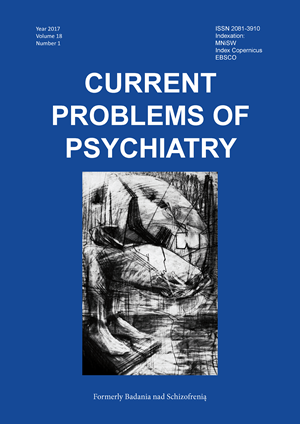Terminal lucidity
DOI:
https://doi.org/10.1515/cpp-2017-0003Keywords:
terminal lucidity, lightening up before death, end of life experience, memoryAbstract
Terminal lucidity is a term used in the medical literature to determine the improvement of mental functioning shortly before death, even among patients with serious and long-term disorders. In 19th century, cases of mind clarity recovery shortly before death, were often recognized by doctors and interpreted as a sign of an impending death. In 20th century, the interest in this phenomenon decreased and then, virtually disappear. In recent years, on the wave of publications concerning near death experiences and related events such as the end of life experiences, papers about the improvement of mental functioning shortly before death, exponentially grew and got a new name, terminal lucidity. In this paper, an overview of the available literature is presented to outline the historical, phenomenological and clinical picture of this phenomenon and its possible implications for medical care and future studies.References
1. Nahm, M., Greyson, B., Kelly, E. W., & Haraldsson, E. (2012). Terminal lucidity: A review and a case collection. Archives of gerontology and geriatrics, 55(1), 138-142.
2. Rush, B. (1812). Mental inquiries and observations upon diseases of the mind. Philadelphia, PA: Kimber & Richardson.
3. Halford, H. (1842). Essays and orations, read and delivered at the Royal College of Physicians: to which is added an account of the opening of the tomb of King Charles I. John Murray.
4. Brierre de Boismont, A. (1845/1859). A history of dreams, visions, apparitions, ecstasy, magnetism and somnambulism. Henry Renshaw, 356, STRAND. London
5. Hughes, N., & Clark, D. (2004). " A Thoughtful and Experienced Physician": William Munk and the Care of the Dying in Late Victorian England. Journal of palliative medicine, 7(5), 703-710.
6. Munk W (1887). Euthanasia: or, Medical Treatment in Aid of an Easy Death. London: Longmans, Green and Co.
7. Macleod, A. S. (2009). Lightening up before death. Palliative and Supportive Care, 7(04), 513-516.
8. Nahm, M., & Greyson, B. (2009). Terminal lucidity in patients with chronic schizophrenia and dementia: A survey of the literature. The Journal of nervous and mental disease, 3(12), 942-944.
9. Marshal, A. (1815). The morbid anatomy of the brain in mania and hydrophobia. London, England: Longman.
10. Raymond, M. (2011). Życie po życiu. Zysk i S-ka: Poznań.
11. Nahm, M. (2011). Reflections on the Context of Near-Death Experiences. Journal of Scientific exploration, 25(3).
12. Fenwick, P., Fenwick, E. (2008/2014). El arte de morir. Editorial Atalanta: Girona, España.
13. Nahm, M. (2009). Terminal lucidity in people with mental illness and other mental disability: An overview and implications for possible explanatory models. Jounal of Near-Death Studies, 28(2), 87-106.
14. Schubert, G. H. (1967). Ansichten von der Nachtseite der Naturwissenschaft. Darmstadt, Germany: Wissenschaftliche Buchgesellschaft. (Original work published 1808).
15. Haig, S., 2007. The brain: the power of hope. Time Magazine 169, 118-119.
16. Ethier, A. M. (2005). Continuing Education Credit Article Death-Related Sensory Experiences. Journal of Pediatric Oncology Nursing, 22(2), 104-111.
17. Ringger, P. (1958). Die Mystik im Irrsinn. Neue Wissenschaft, 8, 217-220.
18. Nahm, M., & Greyson, B. (2014). The Death of Anna Katharina Ehmer: A Case Study in Terminal Lucidity. OMEGA-Journal of Death and Dying, 68(1), 77-87.
19. Peters, U. H. (1996). The first Royal College. The Psychiatrist, 20(5), 307-307.
20. Fenwick, P., Lovelace, H., & Brayne, S. (2010). Comfort for the dying: five year retrospective and one year prospective studies of end of life experiences. Archives of gerontology and geriatrics, 51(2), 173-179.
21. Macleod, A. S. (2011). The Psychiatry of Palliative Medicine. The dying mind. Radcliffe Publishing.
22. Braithwaite, J.J., & Dewe, H (2014). Occam’s chainsaw: Neuroscientific nails in the coffin of dualist notions of the neardeath Experience (NDE). The [UK] Skeptic magazine, (25) 2, pp24-31; http://www.academia.edu/10060970/Occams_Chainsaw_Neuroscientific_Nails_in_the_coffin_of_dualist_notions_of_the_Near-death_experience_NDE_
23. Goldestein, N., Morrison, R. (2012). Evidence-based practice of palliative medicine. Elsevier Health Sciences.
Downloads
Published
Issue
Section
License
Copyright (c) 2017 Authors

This work is licensed under a Creative Commons Attribution-NonCommercial-NoDerivatives 3.0 Unported License.


